|
25th August
Hogganfield Loch
With Central Scotland basking in late summer sunshine, our prayers had
at last been answered after weeks of dismal Sunday weather. We headed
for Ardmore Point, west of Dumbarton, popping into Dumbarton Morrisons
for a wee brekky (7.5/10, very slow service) before disaster struck -
my car wouldn’t start. The AA got the engine started but
advised
me to drive straight to my garage and not to stall on the way. So that
was Ardmore gubbed. It wasn’t all bad though because as we
waited
John spotted an Eyed Ladybird, Anatis
Ocellata,
(a newbie!) on my car bonnet. We got home by mid afternoon and John
called it a day, but I grabbed the wife and her car and headed for a
quick trip to Hogganfield Loch, Glasgow, one of my regular haunts. It
used to be a popular boating pond, but it’s now a Local
Nature
Reserve (LNR). When we arrived I got nice pictures of three of the
“regulars” - Mute Swan, Lesser Black-backed Gull
and
Moorhen.
| Eyed Ladybird |
Mute Swan |
Lesser Black - backed Gull |
Moorhen |
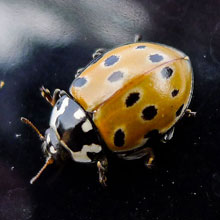 |
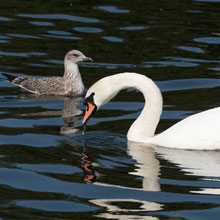 |
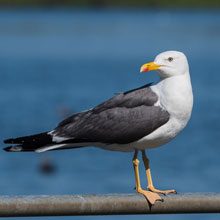 |
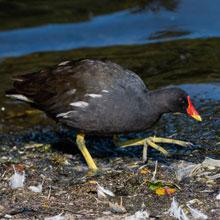 |
After a brief mid-summer
absence the Tufted
Ducks
were back. I presume they were off to breeding grounds as I
don’t
think they breed in the reserve. Most of the Greylags that were here
during winter were gone, but I saw an individual amongst the swans.
Some gaping Cormorants were drying out on perches following spells of
diving for fish. I could also see a few first-year Black-headed Gulls,
easily identified by their white and brown plumage.
| Tufted Duck |
Greylag Goose |
Cormorant |
1st Cycle Black - headed Gull |
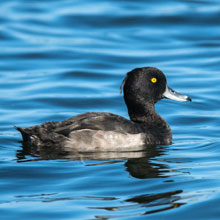 |
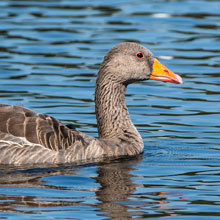 |
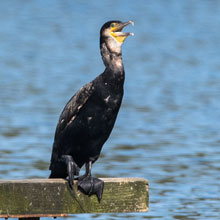 |
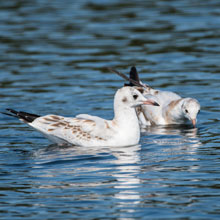 |
I walked along road on
the west side of the Loch watching out for
interesting plants and insects. There were lots of
“Greenbottle” flies, Lucilia
Caesar
on Michaelmas Daisies. Further on, a Buff-tailed Bumblebee was working
its way up a spike of Purple Loosestrife. Nearby, a number of Drone
flies ,
Eristalsis Interruptus, were on more Michaelmas Daisies. I noticed an
unfamiliar caterpillar at the top of a stem of Stinging Nettle. I
identified it later as a Painted Lady larva. There were lots of Painted
Lady butterflies passing, as they had been throughout the summer. The
week before I photographed one on Knapweed, (see “Pictures of
the
Week”, below).
| Fly - Lucilia caesar |
Buff - tailed bumblebee |
Hoverfly - Eristalis interruptus |
Painted Lady Caterpillar |
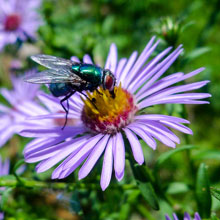 |
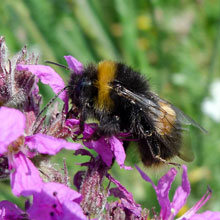 |
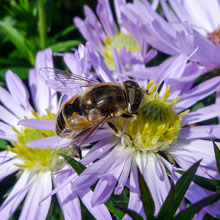 |
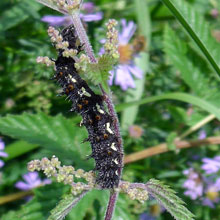 |
I noticed a plant I had
only seen further south (Lake District), Great
Burnet, a member of the Rose family. The plant was once used in
wine-making. It was in a particularly pretty lochside section of
wildflowers including Purple Loosestrife, Wild Angelica and Bittersweet.
A much despised insect, the Common
Wasp , was
feeding on one of the Wild
Angelica flower
heads (see “Pictures of the Week”, below).
| Great Burnet |
Purple Loosestrife |
Wild Angelica |
Bittersweet |
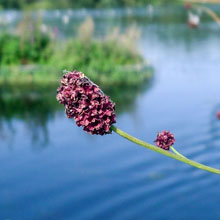 |
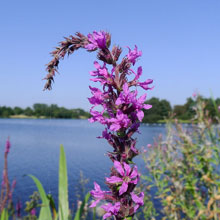 |
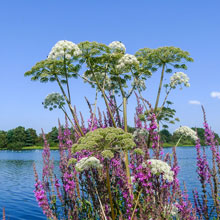 |
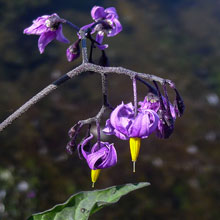 |
I followed the lochside
path running east past a small pond where a
Grey Heron sometimes stands motionless and unconcerned by the many
passers by. At the start of the month I photographed a pair of mating
Common Blue Damselflies lingering at edge of the pond. Also on that
occasion I heard the familiar and chilling call of the Common Buzzard .
It actually flew low overhead and was probably a young bird flexing its
wings and testing the air. It was a bit quieter on Sunday but my
interest was stimulated as I observed how much Water Mint was
decorating the pond’s edge and drainage ditch.
| Grey Heron |
Common Blue Damselfly |
Common Buzzard |
Water Mint |
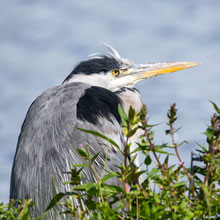 |
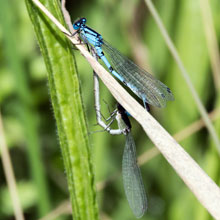 |
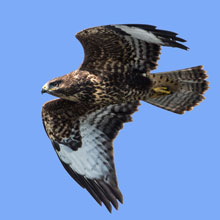 |
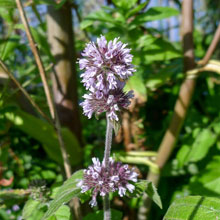 |
I made my way off of the
main tarred footpath along a rougher path that
gave good views over another pond. As I walked slowly along the path I
came across a few Dragonflies sunning themselves on the warm gravel,
(see “Pictures of the Week”, below, one I snapped
there
recently). As I looked onto the pond and I recalled my last visit when
I startled a Grey Heron that flew west and drew my eyes to a Roe
Buck grazing
in the long grass. It looked as though it was blind in the right eye.
Eventually it strolled into the long grass and out of sight behind
Hawthorn bushes. On Sunday there were a few eclipse Gadwalls lounging
and preening in the low sun, but little else. I did though manage some
shots of a Sunfly
dining on a pathside Knapweed flower. The Sunfly common name probably
came about from a misreading of the Greek/Latin scientific name,
Helophilus Pendulus, which actually means “dangling
marsh-lover”.
| Grey Heron |
Roe Deer |
Gadwall |
Hoverfly - Sun Fly |
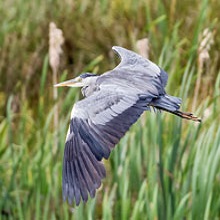 |
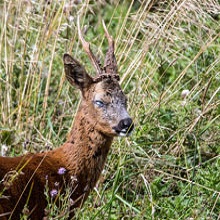 |
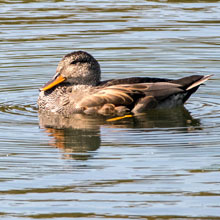 |
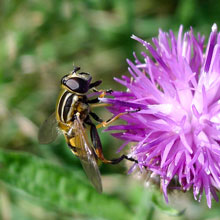 |
I moved to the north
path that ran west back onto the main lochside road. I noticed some Sneezewort
on the verges of the path. These were once used to induce sneezing (not
to cure it!). I also noticed some beautiful, vivid yellow Goldenrod,
Solidago Virgaurea, by some dense Hawthorn thickets. I also caught a
delicate Chequered Hoverfly feeding at the centre of a Dog Rose. The
slopes of the grassy hillock overlooking the lochside road were filled
by flowers of Devil’s
Bit Scabious . I
got a picture of a Peacock butterfly on one of those charming flowers.
The last stage of my
circuit of the reserve I watched a Common Wasp
chase a Peacock butterfly that was peacefully probing a
Knapweed
flower. As soon as I captured that interaction I noticed a Great Crested
Grebe fishing near the side of the Loch (also see “Pictures of
the
Week”, below). I saw no signs of the chicks I had seen 10
days
earlier. That maybe had something to do with a guy in his canoe who was
obviously unaware the Loch was no longer a boating pond.
| Peacock Butterfly |
Great Crested Grebe. |
Juvenile Great Crested Grebe |
|
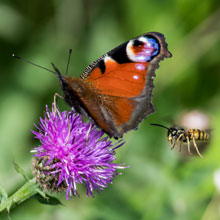 |
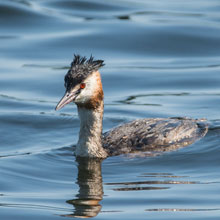 |
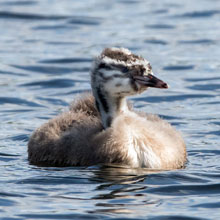 |
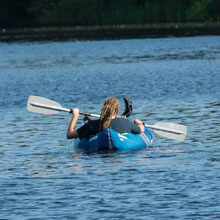 |
We had walked slowly
around the reserve, seeking the shade, as it was
very warm in the sun. I had acquired the day’s cakes and flask
of
tea when I switched cars. The lemon cream muffins were delicious. As we
ate the muffins I reflected on how I’d managed to redeem to day
through a simple one hour circuit of sunny Hoggie! That was satisfying
but then I remembered the hassle with the car... and what’s
the
odds of next Sunday being sunny? ( or having a car!!! Ed.)
Pictures of the Week
| Painted Lady Butterfly |
Common Wasp |
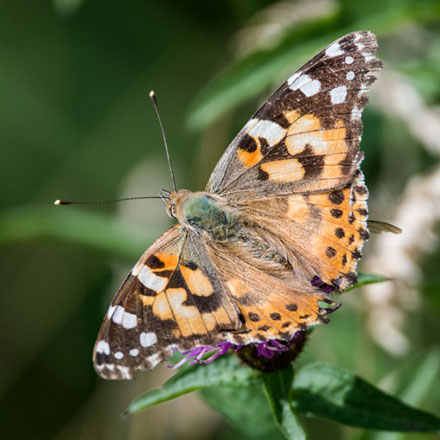 |
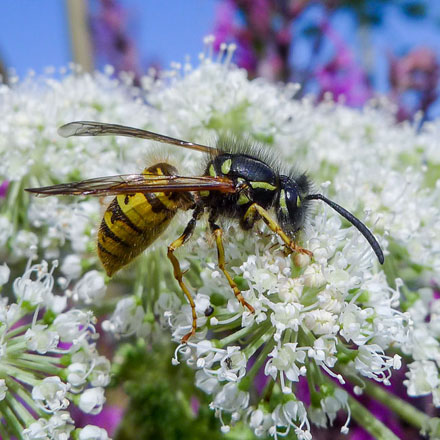 |
| Dragonfly - Common Darter |
Great Crested Grebe |
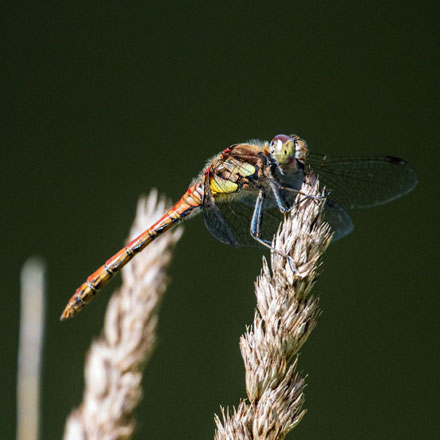 |
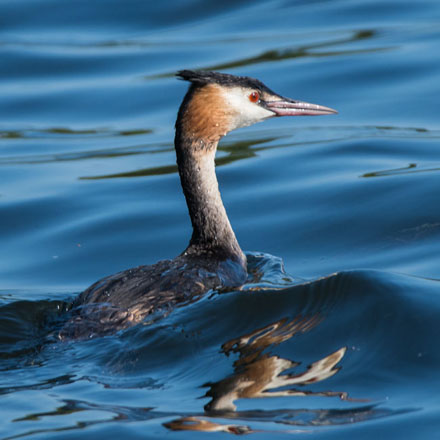 |
18th
August 2019:
Barns Ness
Windy, showery weather
sweeping in from the west was predicted for
Sunday, so I reckoned it might have burned itself out by the time it
reached Dunbar. Our records showed that we had not visited Barns Ness
in 2019, so that’s where we headed. Our customary breakfast
in
Dalkeith Morrisons was excellent as usual (9.5/10) and set us up nicely
for the day. At the car park at Barns Ness an information board
describes how it is an important
geological site.
It contains the most extensive limestone outcrops in central Scotland.
As we arrived we could see a fair bit of that outcrop as the tide was
very low. After parking we set off on an anti-clockwise route around the
area starting with a stroll through the old caravan site. As soon as we
set foot there we couldn’t believe the number of butterflies
we
saw. In the space of a few minutes I had photographed Red
Admiral , Peacock , Small
Copper and Wall
butterflies. From the pictures below you can see that some of them were
a bit “worse for wear”. It was late in their season
and
they had probably passed across many thorny bushes by the time we saw
them. Apparently the
hindwings,
which the pictures below show to be damaged, aren’t needed
for
normal flight, but are needed for “evasive” flight.
| Red Admiral Butterfly |
Peacock Butterfly |
Small Copper Butterfly |
Wall Butterfly |
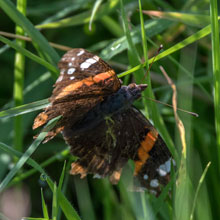 |
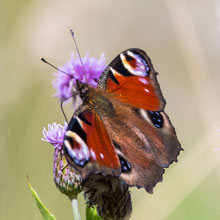 |
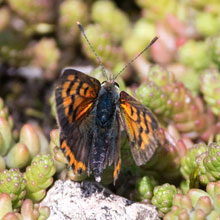 |
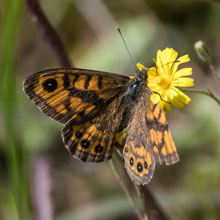 |
Some flowers remained
from the time of the caravan site. I snapped a
Carder Bee on some lovely Sweet Pea flowers. In the same spot I was
pleased to see neat purple flowers of Greater Periwinkle and luscious
deep orange Montbretia blooms. John pointed out a pair of juvenile
Starlings loitering on a power line.
| Common Carder Bumblebee |
Greater Periwinkle |
Montbretia |
Juvenile Starling |
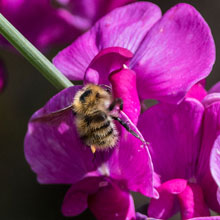 |
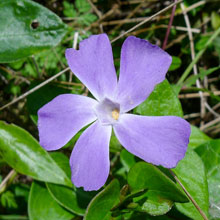 |
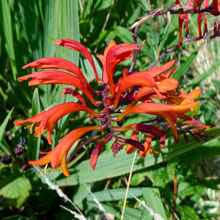 |
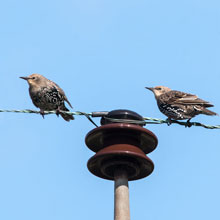 |
With Autumn, season of
“mellow fruitfulness”, just around
the corner, the pretty Brambles were ripening, while the flowers of
Viper’s Bugloss, in full bloom a few weeks ago, were now
starting
to fade as their fruits were forming. We passed patches of sunlit White
Deadnettle that were in full flower but a tiny Teasel plant, growing in
what looked like infertile ground, had lost its tiny purple petals and
was almost ready to bear seeds.
| Bramble |
Viper's Bugloss |
White Deadnettle |
Teasel |
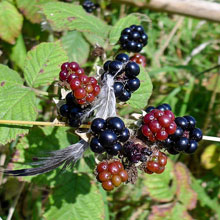 |
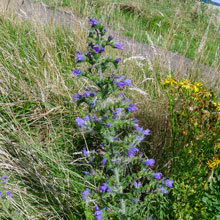 |
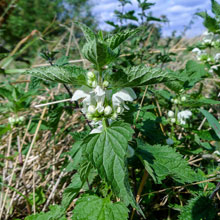 |
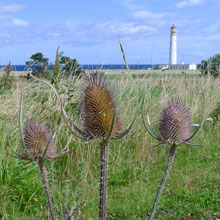 |
As we left the old
caravan site we met even more ragged butterflies. A pair of mating
Large Whites were
moving acrobatically across the low bushes. A very tousled Painted
Lady landed on
some Common Ragwort. I think it needed a second coat! Next I found a
female Meadow
Brown
presenting on a sheltered area of grass. At first I thought it was a
Gatekeeper until I remembered that it should have a double white spot
in each forewing’s black eye mark (the Meadow Brown has only
a
single white eye mark on each forewing). Also, the hind wing of the Gatekeeper
has an orange smudge). The underwing pattern (seen when the butterfly
rests with its wings brought together) confirmed it was a Meadow Brown.
| Large White Butterfly |
Painted Lady Butterfly |
Female Meadow Brown Butterfly |
Female Meadow Brown Butterfly Underwing |
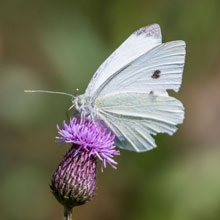 |
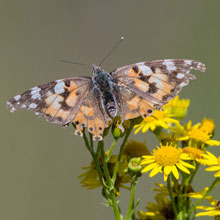 |
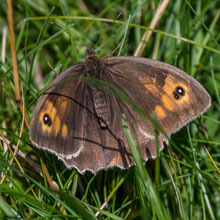 |
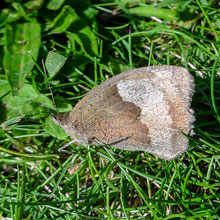 |
As we continued east by
the south east boundary wall I came across a
Dungfly on a Yarrow flower. A bit further along, a Meadow Pipit landed on
the dry stone dyke. We then traversed the fenced off central field to
reach the sandy beach that lies to the east of the lighthouse. The tide
was low and the sea was more than 100m out over very rocky shore that,
at our time of life, would be very risky to cross. We walked towards
the lighthouse hoping for seaweed, as birds are usually attracted to
the invertebrates living in these stinking piles. We were in luck.
There was such a pile and there we found a Carrion Crow flying off with
an orange-coloured titbit. A juvenile Pied Wagtail was also sampling
the food whilst keeping an eye on us as we observed it from the comfort
of our 3-legged stools.
| Yellow Dung Fly |
Meadow Pipit |
Carrion Crow |
Juvenile Pied Wagtail |
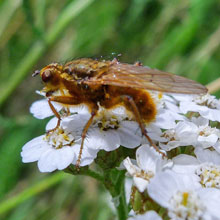 |
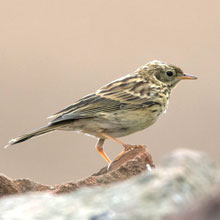 |
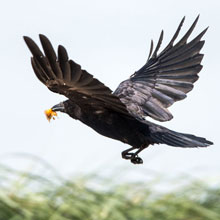 |
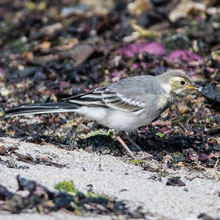 |
Several juvenile
Starlings were squabbling and screeching while they too picked out
tasty morsels. I caught sight of a male Linnet peeking
over the top of some seaweed. It looked as though it was moulting. At
the end of the sands a very pretty Meadow Pipit swooped in briefly
before changing its mind when it saw us (also see, “Pictures
of
the Week”, below). We saw plenty of bird activity happening
along
the distant shoreline, such as fishing Cormorants, passing Gannets and small
wader flocks, but they were frustratingly too far off for decent pictures.
However on the small bay to the west of the lighthouse we had a close
encounter with some small waders. I noticed some Ringed Plovers
foraging the damp rocky sands about half an hour before the tide
advanced to fill the bay. We took up a position on the shore and watched
them as they crept ever closer to us.
| Juvenile Starling |
Linnet |
Meadow Pipit |
Ringed Plover |
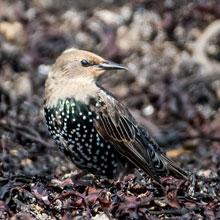 |
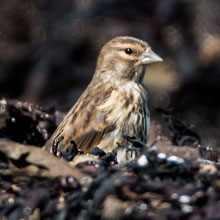 |
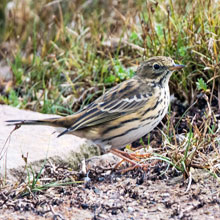 |
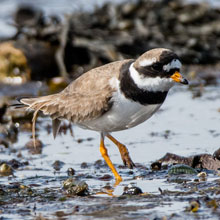 |
The Plovers were soon
joined by Dunlin and then about a dozen
Sanderling flew in. The Dunlin came as close as 5m at times, while the
Ringed Plovers were a bit less adventurous, staying about 8m away and
the Sanderling were very cautious, keeping to at least 20m from where
we sat (also see, “Pictures of the Week”, below for
more
wader shots). We had a narrow escape as a Grey Heron defecated as it
passed overhead. Luckily its droppings landed on the grasses beyond the
shore.
| Dunlin |
Sanderling |
Grey Heron |
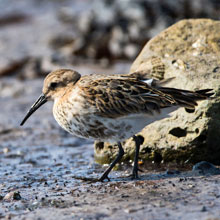 |
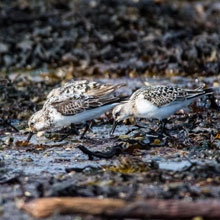 |
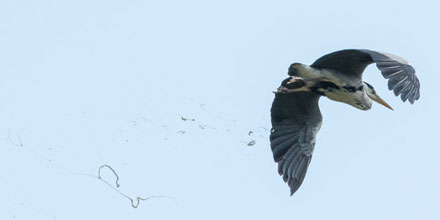 |
We returned to the car
after observing the waders until they flew off as
the bay filled with seawater. A rain shower encouraged us to relocate to
Belhaven Bay for our tea and chocolate cream eclairs. We agreed the
visit had been blessed with brighter weather than the visits of the
previous 4 weeks and our pictures certainly benefited. Highlight of the
day was certainly the wader experience closely followed by the butterfly
experience at the beginning of the walk.
Pictures of the Week:
| Meadow Pipit |
Juvenile Male Ringed Plover |
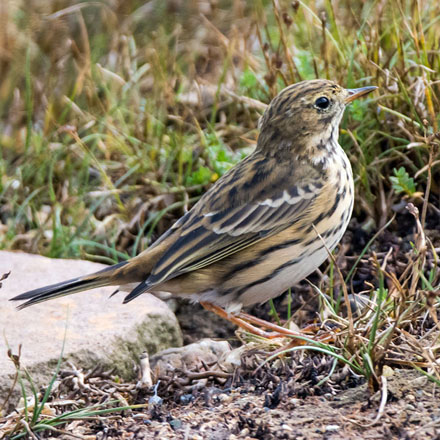 |
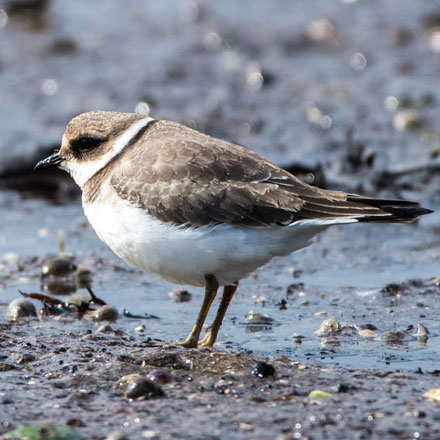 |
| Dunlin |
Sanderling |
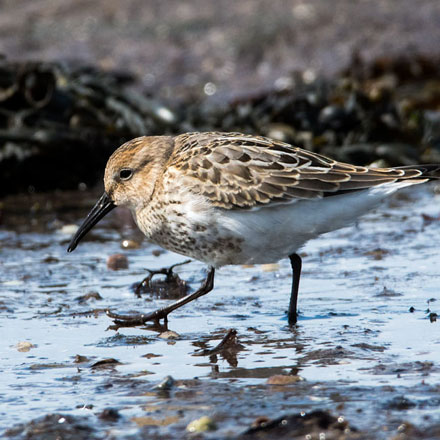 |
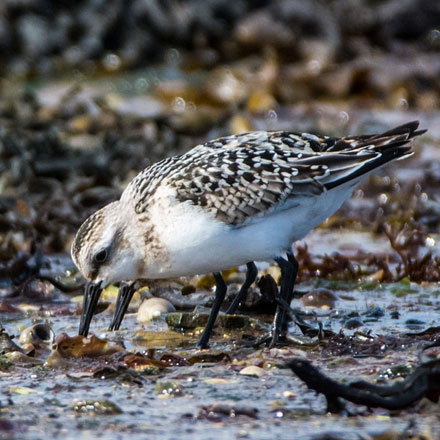 |
11th
August 2019:
Musselburgh and Port Seton
Our run of dull Sundays
continued this week, but with added wind and
rain. We just went for for it, expecting to get wet whichever way we
went, choosing Musselburgh, since birds were reported there (Spotted
Redshank, Ruff, Garganey, Greenshank). So with raincoats at the ready we
sped east, popping into Dalkeith Morrisons for a couple of breakfasts
(9/10: VG but bacon a tad cool) before parking at the Scrapes. The rain
hadn’t quite got going when we first arrived so we made the
most
of it, searching (unsuccessfully) for the Spotted Redshank.
A big Curlew was grazing in front of the hide but apart from a
Black-headed Gull and a few Oystercatchers nothing else was very close.
There were masses of birds at the middle back hide but most of those
were roosting. A few arriving Sandwich
Terns
livened them up slightly, as did a passing Fox (see Pictures of the
Week“, below), that prowled behind the Scrapes but
didn’t
attempt to take any birds.
| Curlew |
Black - headed Gull |
Oystercatcher |
Sandwich Tern |
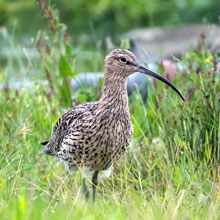 |
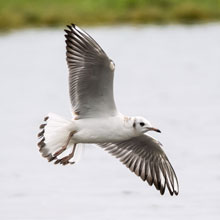 |
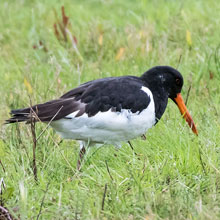 |
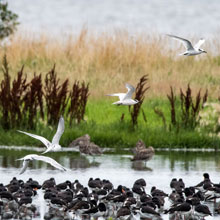 |
A Common
Sandpiper
flitted onto the concrete ring in front of the middle hide. A couple of
tardy Mallards looked on. We moved to the north hide where lots of
birders were seeking the Spotted Redshank (unsuccessfully). John
pointed out a young Grey Heron far to the right, and soon after a
Ruff
flew in briefly before disappearing to the left. At that point the rain
came on in earnest, and it only got heavier for the remainder of the
visit.
| Common Sandpiper |
Mallard |
Juvenile Grey Heron |
Juvenile Ruff |
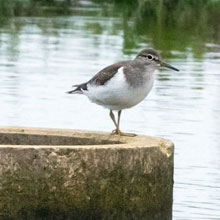 |
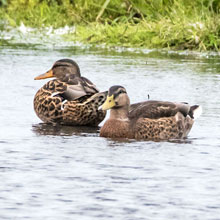 |
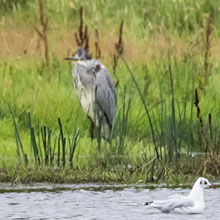 |
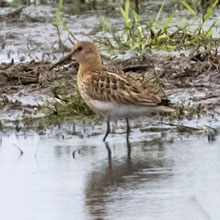 |
We relocated to the
River Esk near the Millhill car park where it was
more sheltered from the stiffening wind. I noticed some nice wild flowers
as I got out of the car. Green
Alkanet , whose leaves
stay green throughout the year, was growing close to a wall alongside
some less pretty, but edible (apparently) Smooth
Sow Thistle. Hidden behind
those was a patch of Herb
Robert
, it’s flowers dotted with raindrops. It has a range of
traditional medicinal uses which are largely untested by modern
science. As we set off along the river I photographed a Yarrow
plant growing by a tree. Yarrow is also known as Carpenter's Weed as
they sometimes use it to stop the bleeding from inevitable wounds
suffered as part of their work.
| Green Alkanet |
Smooth Sow Thistle |
Herb Robert |
Yarrow |
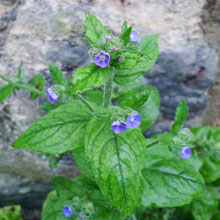 |
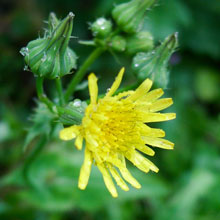 |
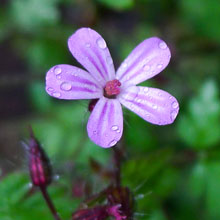 |
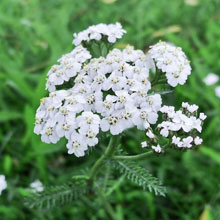 |
A few Canada Geese were
on the riverbank nibbling grass and Feral
Pigeons were moving amongst them picking up whatever they could eat. On
the river a few Greylags were wading in shallows around the island,
where a Moorhen was munching Willowherb.
| Canada Goose |
Feral Pigeon |
Greylag Goose |
Moorhen |
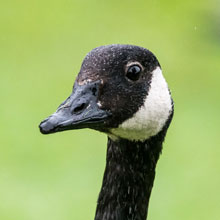 |
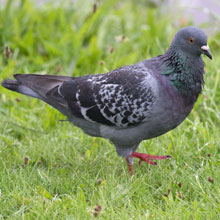 |
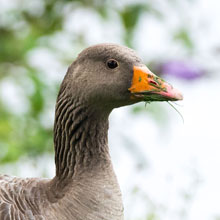 |
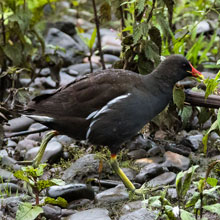 |
Jackdaws were patrolling
the area looking for any opportunity of
acquiring food. A hybrid duck (possibly Mallard X Duclair) paddled into
view. As I photographed the duck, a handsome piebald
Feral Pigeon
flew onto the fence. We moved further upstream searching for a Dipper. I
spotted one under the far arch of the Rennie Bridge and immediately
crossed the bridge to try to get a better picture. Taking care not to
spook the bird I managed a reasonable shot (see Pictures of the
Week“, below). With the rain getting heavier we decided to
move
to Port Seton for a quick look before heading home. As we passed the
footbridge on our way to the car we came across a hybrid goose, a
Canada Goose and Greylag cross.
| Jackdaw |
Duclair Duck x Mallard |
Piebald Feral Pigeon |
Canada x Greylag Goose |
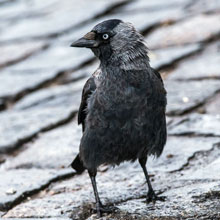 |
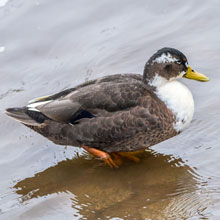 |
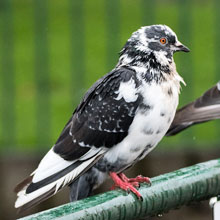 |
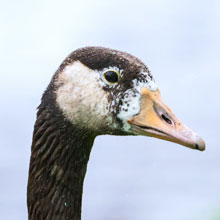 |
After a short drive east
to Port Seton the rain was now persistent and
the wind strong. Nevertheless, we had a short spell scanning the shore
and Harbour for anything interesting. A Black-tailed Godwit was using
its dagger-like beak to probe the sands for invertebrates with a few
Ringed Plovers scurrying around. The tide was disappointingly low
meaning most birds were too far away for decent shots. Clinging to the
rocks 100m out there was a large flock of Sandwich Terns. We saw a few
more near the harbour so we decided to investigate. On our walk there I
snapped a ubiquitous Pied Wagtail moving on the shore just below the
promenade.
| Black - tailed Godwit |
Ringed Plover |
Sandwich Tern |
Pied Wagtail |
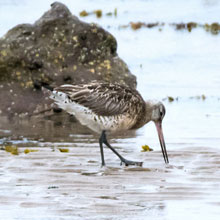 |
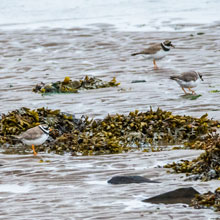 |
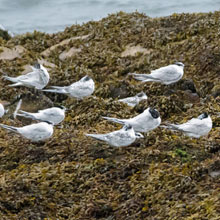 |
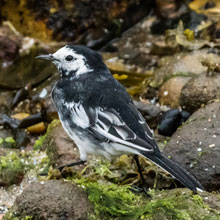 |
View of Port Seton
Harbour taken from the harbour mouth:
At the very blustery and
wet harbour mouth a Grey Seal gave us the once
over before diving and reappearing briefly offshore. It was probably
waiting for the return of a fishing boat, hoping for some scraps from
the fishermen. A Shag flew past, close in from the west (see
Pictures of the Week“, below). As a fishing boat boat
approached
the harbour, a Goosander paddled furiously to get out of its way. And
with that we had had enough of the weather so we retired to the car,
our coats beginning to saturate with water.
| Grey Seal |
Female Goosander |
Sandwich Tern |
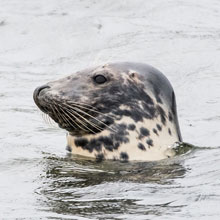 |
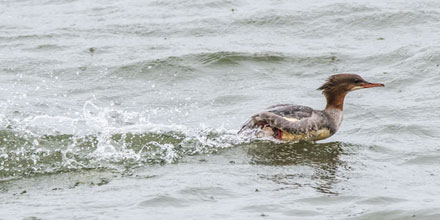 |
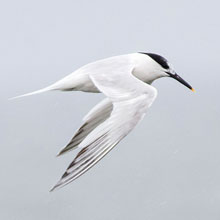 |
As we sipped our tea and
devoured our cream jam scones in the comfort
of the warm car, we both agreed that we’d done well to
accumulate
some good photos on such a dreich day. OK, we dipped
on a few birds - but so did the other birders we met. Surely though,
after a month of inclement Sundays, by the law of averages at least, we
must get decent weather next week?
Pictures of the Week:
| Red Fox |
Dipper |
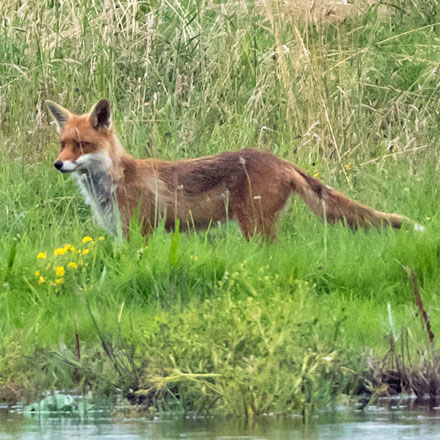 |
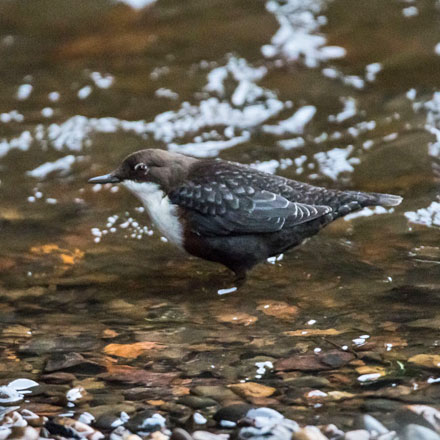 |
| Grey Seal |
Shag |
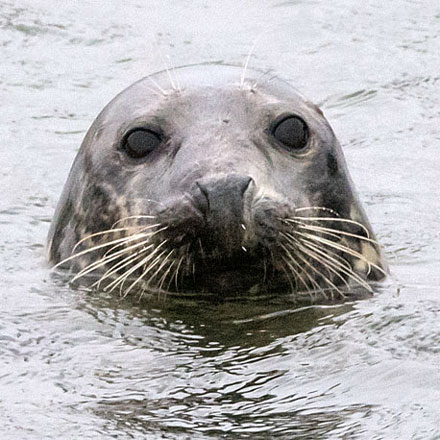 |
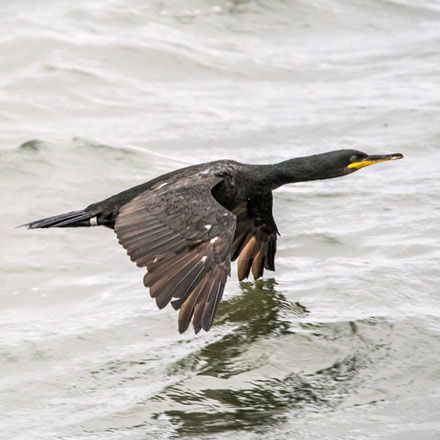 |
4th
August 2019:
Maidens and Turnberry Lighthouse
Well it happened again.
A week of good weather then Sunday’s
weather was to have been dull and damp. On checking my weather app I
saw that there was a chance of brighter weather in south-east Ayrshire,
as the front moved east. We headed for Maidens and Turnberry, places we
hadn’t visited since the middle of last year. We had
breakfast at
Stewartfield Morrisons, East Kilbride (9.5/10: excellent) and made the
long drive down the M77 and A77 (made longer because of a diversion at
Kilmarnock) to Maidens, a former fishing village just south of
Culzean Castle.
The tide was fairly low
when we arrived and a few birds were foraging
on the exposed harbour bed including Dunlin, a Common Gull and a
Herring Gull. We walked out along the north side of the harbour and
could see more Dunlin and a great number of gulls on the south end of
the extensive beach. A juvenile Pied Wagtail flitted across our path,
although it took a bit of spotting as the light was very poor due to
the overcast sky.
| Dunlin in
Breeding plumage |
Common Gull |
Herring Gull |
Juvenile Pied Wagtail |
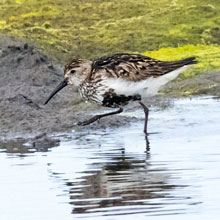 |
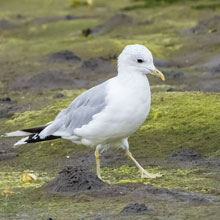 |
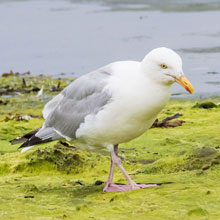 |
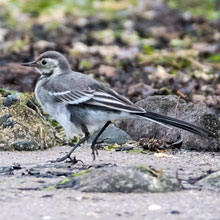 |
A Ringed
Plover
was standing to attention, anxiously minding its pair of young, who
were inexperienced enough to hang about watching our approach (also see
“Pictures of the Week”, below). We gave them a wide
berth
so as not to disturb them too much. A small group of Dunlin flew past in
a flash on their way from the beach to the harbour. I snapped a shot of
a distant Curlew picking its way along a temporary stream in the middle
of the sands.
| Oystercatcher |
Ringed Plover |
Dunlin
in Breeding plumage |
Curlew |
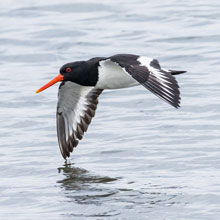 |
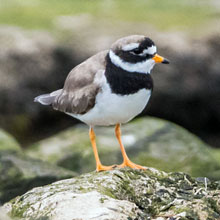 |
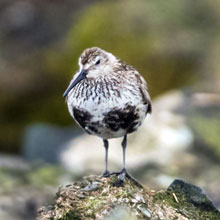 |
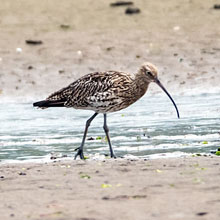 |
A view of Maidens
Harbour from the
beach:
A noisy Oystercatcher
skimmed the water as it sped past. A dozy Dunlin
paid it little notice. As we sat scanning the beach I took a picture of
a lonely
Dog Whelk
stuck on top of a large boulder. These live in the zone between low and
high tides (unlike the larger Common Whelk, which
doesn’t live
in the inter-tidal zone). I managed to grab a shot of an
elusive
Rock Pipit as it scurried around the rocks.
| Oystercatcher |
Dunlin |
Dog Whelk |
Rock Pipit |
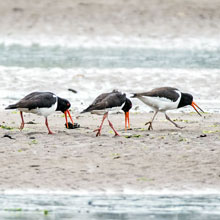 |
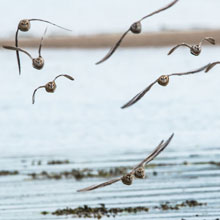 |
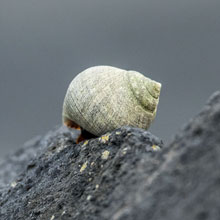 |
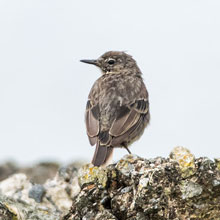 |
As we made our way back
to the car the light improved a bit. This
seemed to encourage the insect world into action. We could see bees on
the Perennial Sow Thistles and a few Painted Lady butterflies
skirting the taller vegetation of the foreshore. We watched a pair of
Large White butterflies as they got frisky on some Sea Radish. Our final
capture at Maidens was of a solitary male Pied Wagtail chasing flies on
the deserted football pitch. I tried to edge closer to it for a better
shot, but each time I nudged closer it fluttered further away.
| Perennial Sow Thistle |
Painted Lady Butterfly |
Large White Butterfly |
Pied Wagtail |
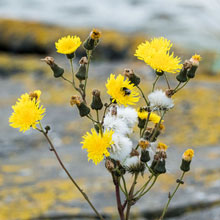 |
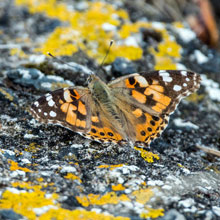 |
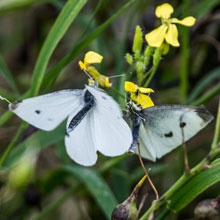 |
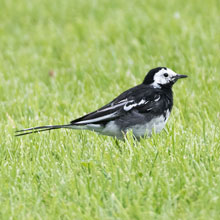 |
With the sun breaking
through, we decided to try our luck about a mile
to the south at Turnberry Lighthouse. The site is part of Trump
Turnberry golf course. We parked in a small recently-built car park and
set off on a 600m walk along a tarred road across the golf course to the
lighthouse. The roadside is lined with bushes and rough grassland, as
well as, as you would expect, manicured golf course grasses. We have
found the road fairly productive in the past, and Sunday was to prove
no different. Our first sighting was of a huge queen Buff-tailed
Bumblebee on
Heather (Ling, Calluna
Vulgaris )
(see “Pictures of the Week”, below). Further on
John drew
my attention to a pair of Carrion Crows on a putting green. I started
snapping straight away since I noticed that it was a parent Crow with
its offspring, which was demanding food. The adult dutifully obliged
with a small worm. Midway along the route John found our top spot of
the visit, a Spotted
Flycatcher
perched on a way marker. We have a lot in common with these bird as we
both were looking for moths, butterflies and damselflies. But we only
want to take their pictures rather than eat them. We passed lots of
wildflowers of interest but the rain was coming on and the light had
dimmed dramatically so I hoped the light level would have improved on
the way back. Eventually we reached the lighthouse and, ignoring the
rainy squall, we moved round it to take up position on the rocks that
overlook the sea and sat out the brief. Immediately I got a dim shot of
a Rock Pipit and soon after that, a juvenile Black-headed Gull glided
past.
| Carrion Crow |
Spotted Flycatcher |
Rock Pipit |
1st Cycle Black - headed Gull |
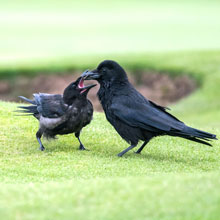 |
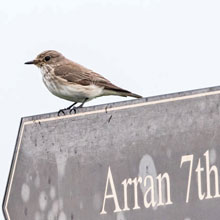 |
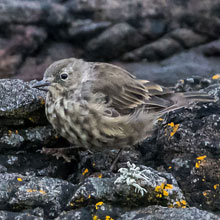 |
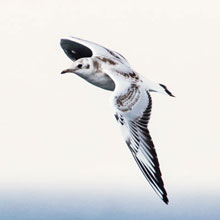 |
As the light improved
slightly I got some reasonable shots of a passing
Shag and then a gaping Cormorant. The next bird to pass is one of our
favourites, the Gannet. It came fairly close in nice light so I got a
fairly good photograph. Like a beginner, as I examined my efforts on my
camera viewfinder, the Gannet did a u-turn and dived into the water
before I had time to raise the camera. As we started back, I got a nice
shot of an Oystercatcher posing on top of a rock.
| Shag |
Cormorant |
Gannet |
Oystercatcher |
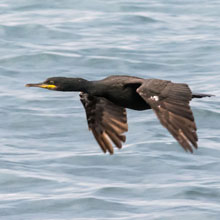 |
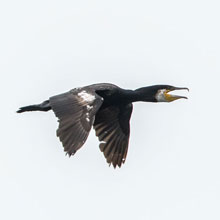 |
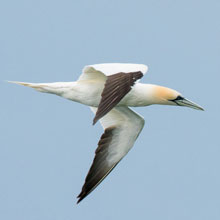 |
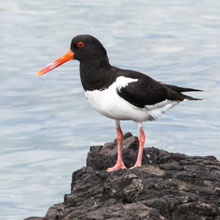 |
Looking over the ruin of
Turnberry Castle I could see just north of
there, a small, rocky island where the Shags and Cormorants had
probably been coming from. I found out later it was called Yellow
Craig. From a distance it looked as though the birds may have been
nesting there. There was a steady stream of golfers teeing off on the
7th hole, “Roon’ the Bend”, that
overlooks the Bay.
Most of the golfers I passed seemed to have transatlantic accents. I
photographed lovely Field Bindweed that is common on the grassy banks
around that part of the coast. I was pleased to see a newbie too, a Pied
Hoverfly feeding on a
purple Knapweed flower. Like the Painted Lady it is a migrant from
Europe and North Africa.
| Yellow Craig |
Gowf |
Field Bindweed |
Pied Hoverfly |
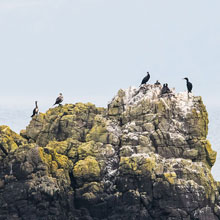 |
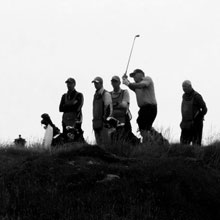 |
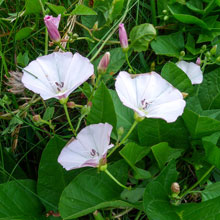 |
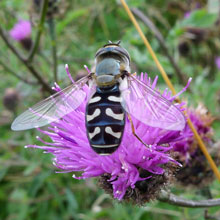 |
We retraced our steps in
bright sunshine, back towards the car park. A monument
on raised ground to the north dominated the view. A tall grey cross
inscribed to the memory of airmen who had flown from the WW2 Turnberry
Airfield, erected by people of the area. Traces of the runways still
remain. As we paused to let golfers tee off I spied a bedraggled
Green-veined White butterfly as it paused on a Cats Ear flower. Next I
captured my favourite shot of the day, a Small Copper on Crooked
Thistle (see also “Pictures of the Week”, below).
And, to
complete a trio of butterfly finds, I managed a fairly decent photo of a
butterfly that had given me the runaround for the whole day, a Meadow
Brown, feeding on a Bramble flower.
| Monument |
Green - veined White Butterfly |
Small Copper Butterfly |
Meadow Brown Butterfly |
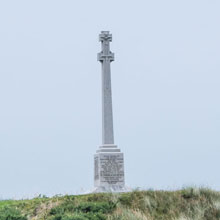 |
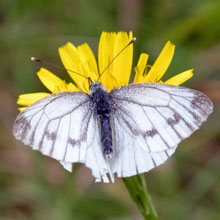 |
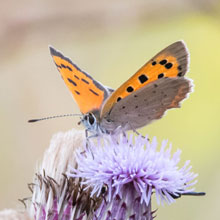 |
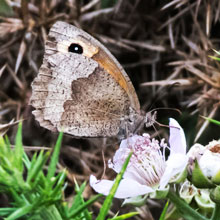 |
In an uncultivated area
of the golf course there were lots of Harebell
flowers nodding in the gentle breeze. By the next golf hole we passed
there was a timid, and puzzled juvenile Starling. A golf ball had just
landed on the green, and I think it didn’t know what to make
of
it. A juvenile Pied Wagtail was our penultimate capture. It was aware
of our presence but continued foraging, moving to keep a steady safe
distance between us. With my car it sight, we were ambling to the end
of our walk when we were nearly caught out by a male Yellowhammer
that seemed to come from nowhere to land in front of us on top of a
tall roadside bush. It gave us a wee song before flying off.
| Harebell |
Juvenile Starling |
Juvenile Pied Wagtail |
Yellowhammer |
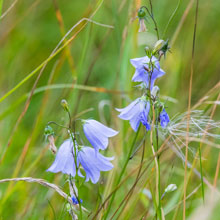 |
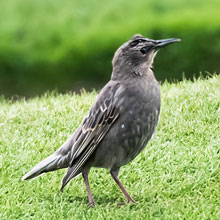 |
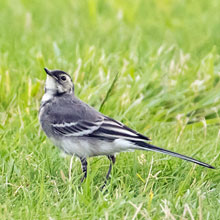 |
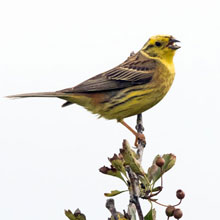 |
So despite the poor
light and occasional light rain we had a very
enjoyable time at each of the sites we visited. The Yellowhammer was
the icing on the cake, but the find of the day has to be the Spotted
Flycatcher. Talking of cakes, we consumed delightfully moist lemon
cream muffins with our tea before tackling the long drive home.
Here’s hoping our run of dull Sundays doesn’t
continue next
week.
Pictures of the Week:
| Ringed Plover |
Juvenile Ringed Plover |
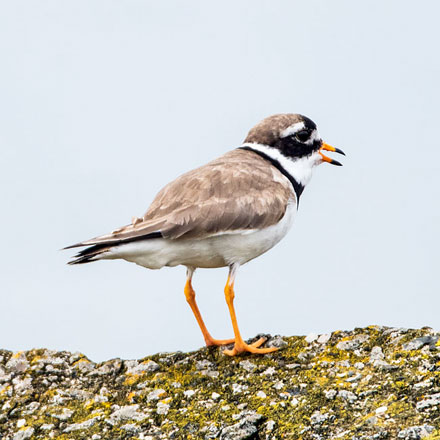 |
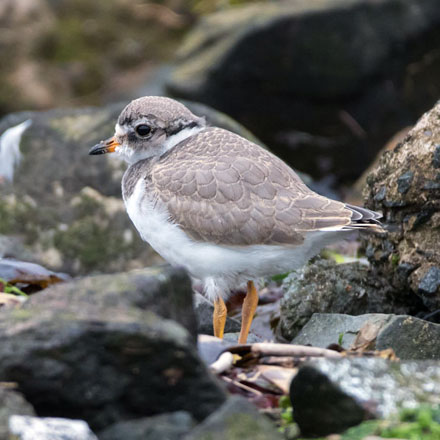 |
| Buff - tailed Bumblebee |
Small Copper Butterfly |
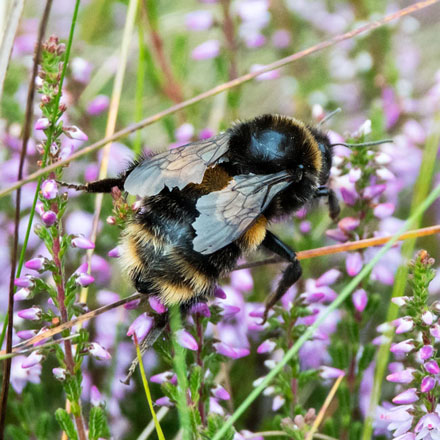 |
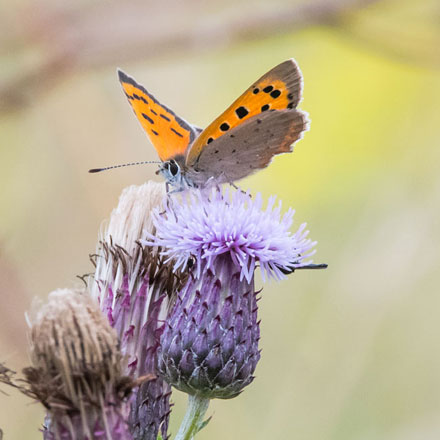 |
Back To
Top |

